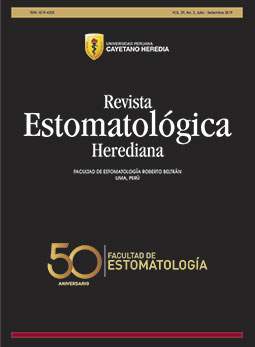Solvent efficiency and cytotoxicity of lemon peel oil (Citrus limon).
DOI:
https://doi.org/10.20453/reh.v29i3.3603Keywords:
Guttapercha; solvents; volatiles oils; toxicity.Abstract
Objective: To evaluate in vitro the solvent and toxic effect of lemon peel oil (Citrus limon) according to exposure time. Its components were identified through gas chromatography. Material and Methods: The study was of experimental type in vitro. To determine the solvent effect, standardized gutta-percha cones of endodontic number 80 with taper 0.02 were used; solvents used were: xylol, lemon and orange peel essential oil; these were immersed in 2, 5 and 10 minutes (n = 8). The weight was recorded before and after the immersion to the substances evaluated to determine the loss of mass. To evaluate the toxicity, Artemias Franciscan were used through the medium lethal concentration; Gas chromatography was used to obtain the components of each oil. The ANOVA / Tukey analysis was used to compare the solvent effect between the substances. Results: No significant difference was found to dissolve the gutta-percha with the lemon, orange and xylol essential oil (p> 0.05). Time did not influence the dissolution of gutta-percha (p> 0.05). All oils were toxic, with the exception of 25% lemon oil. Conclusions: Limonene and D limonene were the components with the highest percentage in lemon and orange oil, respectively. Lemon oil could be considered as an alternative to be used as a gutta-percha solvent for endodontic use, because it has a similar effect as orange oil.
Downloads
Downloads
Published
How to Cite
Issue
Section
License
The authors retain the copyright and cede to the journal the right of first publication, with the work registered with the Creative Commons License, which allows third parties to use what is published as long as they mention the authorship of the work, and to the first publication in this journal.























